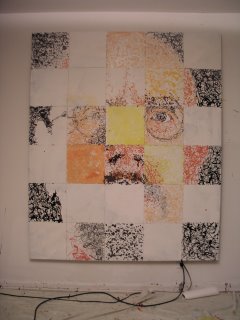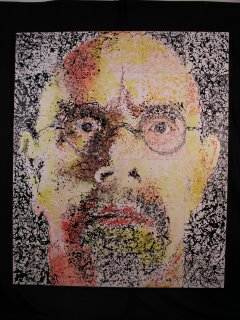Chuck Close Must Be Freaking Out
I thought it might be interesting to demonstrate how a painting--in this case, a grid painting--progresses.
The example here is my painting of Chuck Close. As source material I used the photograph Close took of himself that became the basis for more than one painting of his. This is it:

Here is a shot of my painting in progress and then the final product:


The idea is to paint each square while the adjacent squares are masked off. Working in such a visual "vacuum" creates a disconnect between certain areas of the canvas--the rim of the glasses in his right eye, for example, don't completely line up on the upper-right. Likewise the coloring of his forehead varies considerably from one grid square to the next. And even though I eventually grapple with the painting as a whole, ignoring the grid for the last several layers of paint, the unresolved conflict between the squares creates a low level of visual chaos that enlivens the image.
Quite zippy, I think. It will likely be one of those things art historians point to when they say, "He was the pre-eminent portraitist of his time.
Chuck Close must be freaking out.
The example here is my painting of Chuck Close. As source material I used the photograph Close took of himself that became the basis for more than one painting of his. This is it:

Here is a shot of my painting in progress and then the final product:


The idea is to paint each square while the adjacent squares are masked off. Working in such a visual "vacuum" creates a disconnect between certain areas of the canvas--the rim of the glasses in his right eye, for example, don't completely line up on the upper-right. Likewise the coloring of his forehead varies considerably from one grid square to the next. And even though I eventually grapple with the painting as a whole, ignoring the grid for the last several layers of paint, the unresolved conflict between the squares creates a low level of visual chaos that enlivens the image.
Quite zippy, I think. It will likely be one of those things art historians point to when they say, "He was the pre-eminent portraitist of his time.
Chuck Close must be freaking out.

0 Comments:
Post a Comment
<< Home